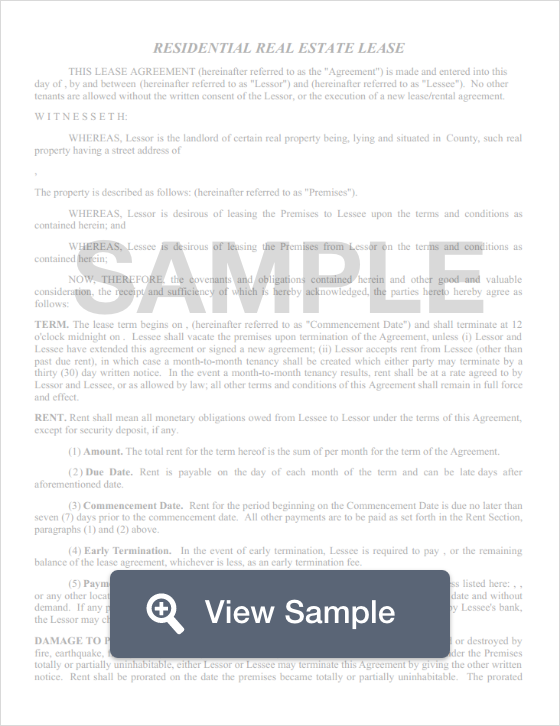Make a Maryland Lease Agreement
Create a Maryland Lease Agreement with our customizable template!

What Is a Maryland Lease Agreement
A Maryland lease agreement is a contract between the landlord or the property management company and the tenant for a specific rental property. After the contract is executed, the tenant can then move into the property. A Maryland lease agreement can be used for residential or commercial property.
Looking for other Maryland documents?

Business
- Maryland Non-Compete Agreement
- Maryland Non-Disclosure Agreement
- Maryland Promissory Note

Personal
- Maryland Last Will and Testament
- Maryland Living Will
- Maryland Power Of Attorney

Real Estate
- Maryland Bill Of Sale
- Maryland Eviction Notice
- Maryland Month-to-Month Lease Agreement
- Maryland Quit Claim Deed
- Maryland Rental Application
- Maryland Sublease Agreement


Sample Maryland Lease Agreement


Search Documents
Related Documents
Looking for other Maryland documents?

Business
- Maryland Non-Compete Agreement
- Maryland Non-Disclosure Agreement
- Maryland Promissory Note

Personal
- Maryland Last Will and Testament
- Maryland Living Will
- Maryland Power Of Attorney

Real Estate
- Maryland Bill Of Sale
- Maryland Eviction Notice
- Maryland Month-to-Month Lease Agreement
- Maryland Quit Claim Deed
- Maryland Rental Application
- Maryland Sublease Agreement
Most Commonly Used Maryland Lease Agreements
The most commonly used Maryland lease agreements include a commercial lease agreement, a standard residential lease agreement, a month-to-month agreement, a lease to own agreement, a roommate agreement, and a sublease agreement.
The most commonly used Maryland lease agreements have all of the same provisions. However, they still have their own features and functions. Here are a couple of examples:
- A roommate agreement is a type of residential lease agreement. It has all of the same provisions found in a standard residential lease. However, it is different since it also explains which areas in the unit are for the exclusive use of the tenant and which areas are common and may be used by all occupants.
- A standard residential lease agreement is usually for one year. When that period ends, it might switch to a month-to-month lease or it might renew for another year. However, a one year lease may be similar to a month-to-month lease in some ways. For example, they both may include a provision that requires a 30-day written notice to move out at the end of the term if either party does not plan to renew the lease.
How to Write a Maryland Lease Agreement
A Maryland lease agreement must comply with Maryland landlord-tenant law. If they don’t, they cannot be enforced in court. There are additional laws that must be considered. We will mention a few under the sections related to disclosures and security deposits.
Before you sign the lease, make sure you read it carefully or have it reviewed by an attorney. Always remember that a lease is a contract.
A Maryland lease agreement should include the following information:
- Names of the Parties - This includes the landlord's full name or the property management company's legal business name and the legal name of the tenant(s).
- Property Address - This is the full physical address of the rental property. It should include the city, zip code, and, if applicable, the lot or unit number.
- Term Information - This provision explains the type of lease agreement the parties agree to enter into. For example, a month-to-month lease or a fixed term. A fixed-term lease means that the parties agree that the tenant will hold possession of the space for a certain amount of time, usually one year. If it is a fixed lease, this section should include the date that the lease will end.
- Rental Amount - This provision includes information such as the date that the lease will begin, the amount of the monthly rent, the day of the month that rent is due, and the address where the rent may be paid.
- Late Fee - This provision provides the amount of the fee that is due if the rent is not paid by a certain date.
- Security Deposit - This provision lists the amount of money that must be paid in advance of the tenant taking control of the property. A security deposit is used to repair damages caused by the tenant.
- Initial Payment - This provision provides the total amount of money that the tenant must pay to move into the property. This area should include the amount of the first month's rent, the security deposit, and the total of the two numbers added together.
- Occupants - This provision documents the full name of each tenant even if they are a minor or are not signing the lease. This provision of a Maryland residential lease agreement establishes who will reside in the residential unit. For commercial space leases, it designates those who have permission to use the space. If the presence of additional occupants changes the price of the rent, it should be included in this section.
- Utilities - This provision explains which utilities or services a tenant does not pay.
- Parking - This provision provides information about parking. If a parking space is reserved and there is a designated spot, the spot should be listed in this section.
- Furnishings - This provision tells tenants what they are allowed to install (such as a washing machine or dishwasher) or what they may not install. If the tenant is not allowed to bring their own appliances, that should be designated in this section.
- Notices - The purpose of this provision is to document the names of the landlord or property manager and tenant along with their respective mailing addresses. This contact information is used if the parties need to send out a notice to the other party for some reason.
- Eviction - This provision informs tenants about how an eviction would be carried out in the event of nonpayment or breach of other lease terms.
- Additional Terms - This provision provides any other terms that the parties agreed to that haven't been included in any other section of the lease agreement.
- Signature and Date - The document should be signed and dated by all parties.
What Disclosures Belong in a Maryland Lease Agreement?
Under Maryland state law, there are several disclosures that must be made.
- The agent and the landlord must be identified. Any person who has the authority of the landlord to be on the premises must have their identity disclosed to the tenant.
- The landlord must provide a move in / move out checklist that must be completed by the tenant within 15 days of the date of occupancy. This helps tenants protect their security deposit.
- There must be a statement that says the property is in livable (habitable) condition and explains the tenant’s responsibility for certain items that must be fixed or paid for (such as heat, electricity, or water).
- The landlord must provide a security deposit receipt. The receipt must also list the tenant’s rights as mentioned in state law.
Under federal law, any residential unit constructed 1978 or before that is rented must include a lead paint disclosure. Maryland landlords renting homes built before 1950 must give the tenant a Risk Reduction Certificate proving that the property has had lead risk reduction measures taken.
What You Need to Know About Maryland Lease Agreement Deposits
A Maryland lease agreement may not request more than two months of rent as a security deposit. The landlord must return the security deposit within 45 days of the end of the lease. If money was used for repairs, the landlord must include a list of itemized deductions.

Create a Maryland Lease Agreement in minutes with our professional document builder.













